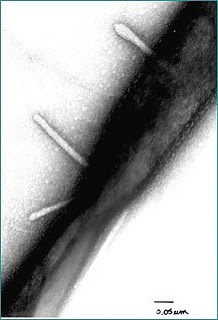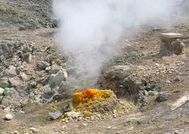Thermoproteus neutrophilus: Difference between revisions
| (12 intermediate revisions by the same user not shown) | |||
| Line 24: | Line 24: | ||
''Thermoproteus neutrophilus'' is commonly found in hot springs and solfataras. It requires high temperatures and elemental sulfur, as an electron acceptor for growth [1]. | ''Thermoproteus neutrophilus'' is commonly found in hot springs and solfataras. It requires high temperatures and elemental sulfur, as an electron acceptor for growth [1]. | ||
[[File:Tn3.jpg|320px|thumb|center|Picture of ''Thermoproteus'']] | |||
==Genome Structure== | ==Genome Structure== | ||
| Line 43: | Line 46: | ||
Members of the genus Thermoproteus are not human pathogens. Thermoproteus inhabits solfataric areas, growing at extremely high temperatures at near neutral pH [1]. | Members of the genus Thermoproteus are not human pathogens. Thermoproteus inhabits solfataric areas, growing at extremely high temperatures at near neutral pH [1]. | ||
''Thermoproteus neutrophilus'' produces hydrogen sulfide, which is a compound that is harmful to human health and a detriment to the environment. The presence of hydrogen sulfide has had an economic impact on the fishing industry. It's presence in marine waters has caused massive reduction in fish populations in ceratin areas [2]. However, since Thermoproteus neutrophilus' natural habitats are isolated to solfataric fields, hot springs, and other extremely hot areas which are not suitable for most forms of life, their toxic impact on other organisms and the environment is relatively limited. However, as previously mentioned, the activity of ''Thermoproteus neutrophilus'' has been linked to pipe degradation in geothermal energy reactors. | ''Thermoproteus neutrophilus'' produces hydrogen sulfide, which is a compound that is harmful to human health and a detriment to the environment. The presence of hydrogen sulfide has had an economic impact on the fishing industry. It's presence in marine waters has caused massive reduction in fish populations in ceratin areas [2]. However, since Thermoproteus neutrophilus' natural habitats are primarily isolated to solfataric fields, hot springs, and other extremely hot areas which are not suitable for most forms of life, their toxic impact on other organisms and the environment is relatively limited. However, as previously mentioned, the activity of ''Thermoproteus neutrophilus'' has been linked to pipe degradation in geothermal energy reactors. | ||
[[File:solfatara.jpg|189px|thumb|center|Picture of a volcanic solfatara]] | |||
==References== | ==References== | ||
| Line 66: | Line 71: | ||
==Author== | ==Author== | ||
Page authored by | Page authored by Emily Rustad and Alison Rosaen, students of [http://www.kbs.msu.edu/faculty/lennon/ Prof. Jay Lennon] at Michigan State University. | ||
<-- Do not remove this line-->[[Category:Pages edited by students of Jay Lennon at Michigan State University]] | <-- Do not remove this line-->[[Category:Pages edited by students of Jay Lennon at Michigan State University]] | ||
Latest revision as of 13:54, 23 April 2011
Classification
Thermoproteus neutrophilus
[Others may be used. Use NCBI link to find]
Species
neutrophilus
|
NCBI: Taxonomy |
Archaea; Crenarchaeota; Thermoprotei; Thermoproteales; Thermoproteaceae; Thermoproteus; Thermoproteus neutrophilus
Description and Significance
Thermoprotesus neutrophilus can be described as hyperthermophilic and chemolithoautotrophic. However, it has been shown to be facultatively autotrophic, using organic carbon sources when present [8].
Microorganisms belonging to the genus Thermoproteus are stiff rods with "golf club" like protrusions on their ends. This structure may contribute to budding [4].
Thermoproteus neutrophilus cells are approximately .4 um in diameter and anywhere between 1-80 um in length. They are nonmotile and lack flagella [3].
Thermoproteus neutrophilus has been suspected of contributing to the corrosion of stainless steel vapor ducts. Vapor ducts are important in the utilization of geothermal energy, a clean source of energy. The impact of Thermoproteus neutrophilus could potentially affect the environment and the economy because decreased energy efficiency is very costly [7].
Thermoproteus neutrophilus is commonly found in hot springs and solfataras. It requires high temperatures and elemental sulfur, as an electron acceptor for growth [1].
Genome Structure
The Thermoproteus neutrophilus genome has 1.77 million base pairs and a circular chromosome. There are 2053 predicted genes. The genome has a GC content of 59.91%. It was originally described in 1983 as belonging the the Thermoproteus genus. However, based on rRNA and protein based phylogenetic trees, it has become clear that it is more closely related to the Pyrobaculum genus, being most closely related to the species Pyrobaculum islandicum [7].
Cell Structure, Metabolism and Life Cycle
Thermoproteus neutrophilus is an extreme thermophile, surviving at temperatures up to 95 C. It is an anaerobically growing, sulfur reducing autotroph [3]. It is able to reduce elemental sulfur to hydrogen sulfide using hydrogen as an electron donor [1]. While not all of the details of T. neutrophilus' metabolism have been completely elucidated, NMR studies have shown that it uses the reductive citric acid cycle to reduce carbon dioxide [5].
Thermoproteus neutrophilus is Gram-negative staining. The cell wall structure of Thermoproteus neutrophilus is somewhat unique. It consists of a cytoplasmic membrane and a hexagonally packed S-layer, with no murein sacculus. The outer side of the S-layer is smooth, while the cytoplasmic surface is sculptured, garnished with dome-like protuberances. The S-layers have a high proportion of hydrophobic amino acids, and pores of 6 nm in diameter. It is the paracrystalline structure of the S-layer that makes it incredibly stable even in the presence of extreme heat and chemical treatment [3].
As previously mentioned, the 16S rRNA sequence of T. neutrophilus suggests that it belongs in the genus Pyrobaculum rather than Thermoproteus. When comparing the genome of the organism Thermoproteus Tenax to Thermoproteus neutrophilus it is clear that Thermoproteus neutrophilus is more similar to Pyrobaculum. Also, Thermoproteus tenax is an acidophile, while Thermoproteus neutrophilus is a neutrophile. However, Thermoproteus neutrophilus do not have flagella (a characteristic of Pyrobaculum), grow at a lower temperature than most Pyrobaculum, and use only elemental sulfur as an electron acceptor (whereas Pyrobaculum species typically are able to use more than one type of electron acceptor) [7].
Ecology and Pathogenesis
Members of the genus Thermoproteus are not human pathogens. Thermoproteus inhabits solfataric areas, growing at extremely high temperatures at near neutral pH [1].
Thermoproteus neutrophilus produces hydrogen sulfide, which is a compound that is harmful to human health and a detriment to the environment. The presence of hydrogen sulfide has had an economic impact on the fishing industry. It's presence in marine waters has caused massive reduction in fish populations in ceratin areas [2]. However, since Thermoproteus neutrophilus' natural habitats are primarily isolated to solfataric fields, hot springs, and other extremely hot areas which are not suitable for most forms of life, their toxic impact on other organisms and the environment is relatively limited. However, as previously mentioned, the activity of Thermoproteus neutrophilus has been linked to pipe degradation in geothermal energy reactors.
References
1. Huber, R. Huber, H. Stetter, K.O. Toward the ecology of hyperthermophiles: biotypes, new isolation strategies and novel metabolic properties. FEMS Microbiology Reviews. 2000. Volume 24. p. 615-623
2. Lavik, G. Stuermann, T. Bruechert, V. Van der Plas, A. Detoxification of sulphidic African shelf waters by blooming chemolithotrophs. Nature. 2009. Volume 457. p. 581-586
3. Messner, P. Pum, D. Margit, S. Stetter, K. Sleytr, U. Ultrastructure of the Cell Envelope of the Archaebacteria Thermoproteus tenax and Thermoproteus neutrophilus. Journal of Bacteriology. 1986. Volume 166 Number 3 p. 1046-1054
4. Stetter, K.O. Fiala, G. Huber, G. Huber, R. Segerer, A. Hyperthermophilic Microorganisms. FEMS Microbiology Reviews. 1990. Volume 75. p. 117-124.
5. Strauss, G. Eisenreich, W. Bacher, A. Fuchs, G. 13C-NMR study of autotrophic CO2 fixation pathways in the sulfur-reducing Achaebacterium Thermoproteus neutrophilus and the in the phototrophic Eubacterium Chloroflexus aurantiacus. European Journal of Biochemistry. 1992. Volume 205. p. 853-866
6. Thermoproteus neutrophilus V24Sta. University of California. Date accessed: 18 April 2011. http://genome.jgi-psf.org/thene/thene.home.html
7. Thermoproteus neutrophilus V24Sta (Thermoproteus neutrophilus V24Sta) Genome Browser Gateway. University of Califonia, Santa Cruz. Genome Bioinformatics Group of UC Santa Cruz. Date accessed: 27 February 2011. http://microbes.ucsc.edu/cgi-bin/hgGateway? org=Thermoproteus+neutrophilus+V24Sta&db=therNeut1&hgsid=544039
8. W. Hugo Ramos-Vera, Valérie Labonté, Michael Weiss, Julia Pauly,, and Georg Fuchs* Regulation of Autotrophic CO2 Fixation in the Archaeon Thermoproteus neutrophilus Journal of Bacteriology, October 2010, p. 5329-5340, Vol. 192, No. 20
Author
Page authored by Emily Rustad and Alison Rosaen, students of Prof. Jay Lennon at Michigan State University.
<-- Do not remove this line-->


